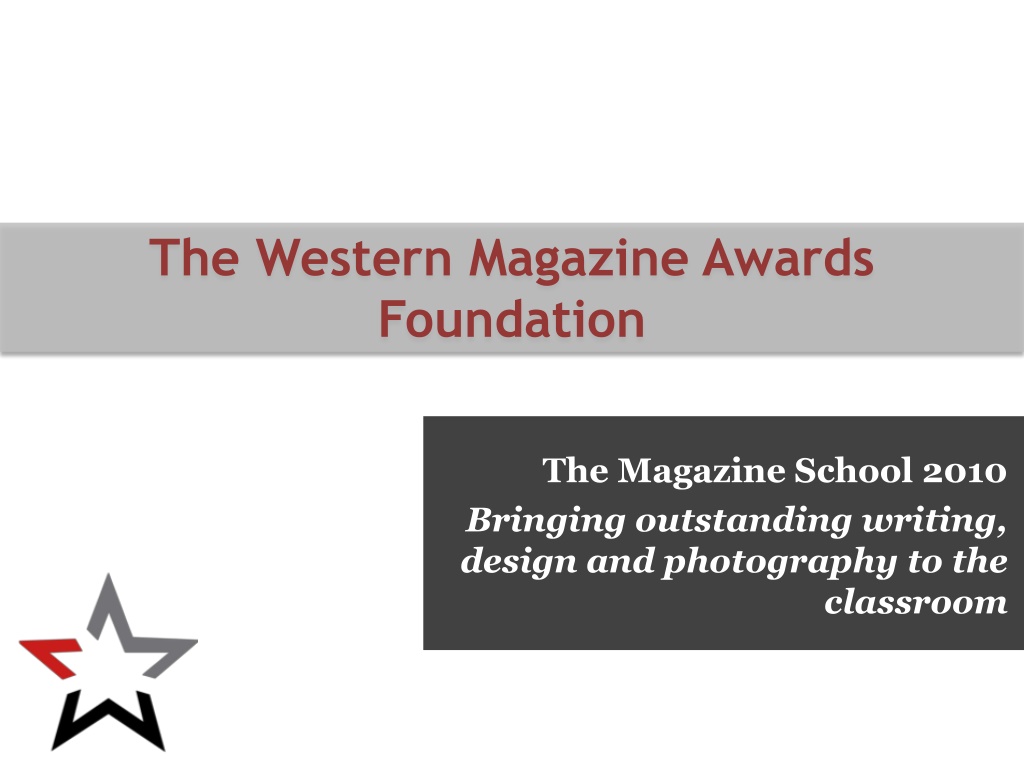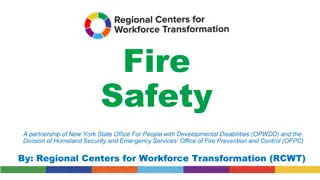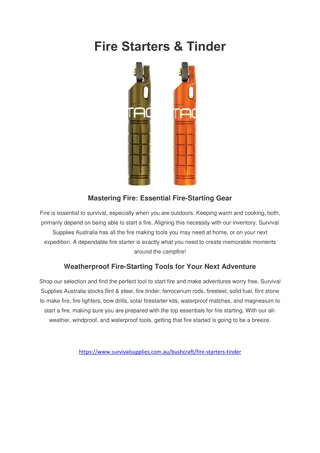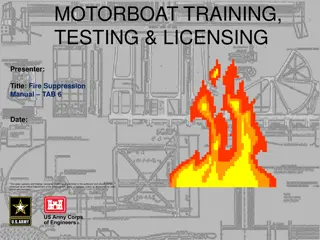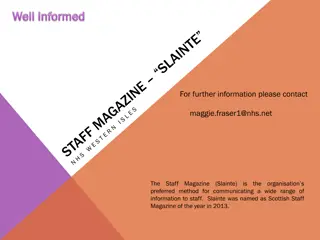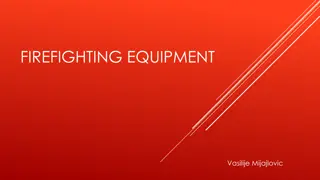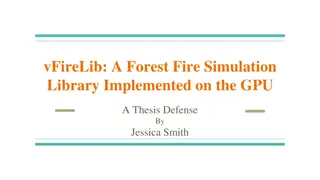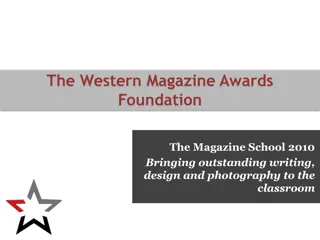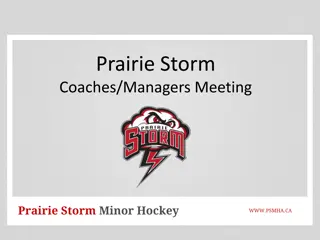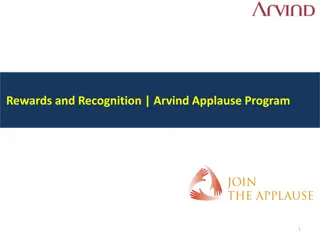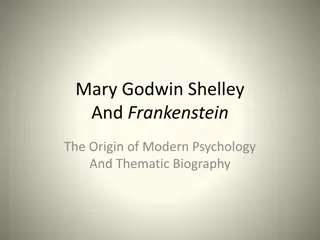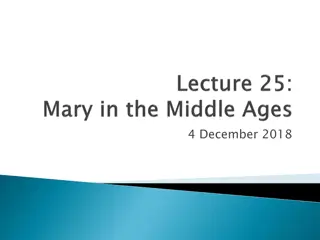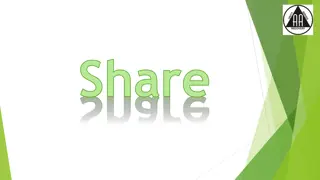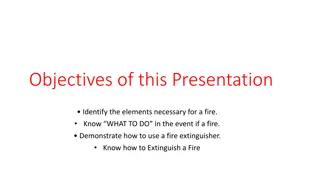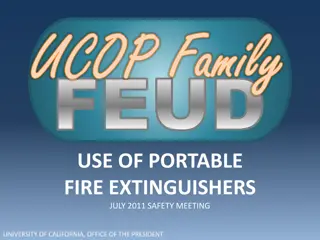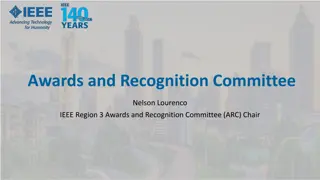Mary Horodyski and Prairie Fire: Western Magazine Awards
Mary Horodyski wins the 2010 Western Magazine Awards Gold Award for Best Article in Manitoba with "The Geography of Ambiguity" published in Prairie Fire, a quarterly magazine known for its engaging content and beautiful design. Learn about Mary Horodyski's background and the unique qualities of Prairie Fire magazine.
Download Presentation

Please find below an Image/Link to download the presentation.
The content on the website is provided AS IS for your information and personal use only. It may not be sold, licensed, or shared on other websites without obtaining consent from the author. Download presentation by click this link. If you encounter any issues during the download, it is possible that the publisher has removed the file from their server.
E N D
Presentation Transcript
The Western Magazine Awards Foundation The Magazine School 2010 Bringing outstanding writing, design and photography to the classroom
Western Magazine Awards Foundation An annual awards program recognizing excellence in Western Canadian editorial work, and design. westernmagazineawards.ca TMS The Magazine School is a project of the Western Magazine Awards Foundation. It provides classroom material to writing and design instructors and professors.
The 2010 Western Magazine Awards Gold Award, Best Article Manitoba Mary Horodyski The Geography of Ambiguity Prairie Fire
Finalists: Gold Award Best Article Manitoba Sponsored by the Manitoba Ministry of Culture, Heritage and Tourism Mark Reid, Valour Sold, The Beaver Meeka Walsh, Natalka Husar: The Implication of Painting, Border Crossings Laurie Block, God of the Father, Prairie Fire Laurie Block, Buenos Aires Cats, Prairie Fire Mary Horodyski, The Geography of Ambiguity, Prairie Fire
And the winner is Mary Horodyski The Geography of Ambiguity Prairie Fire
Prairie Fire Prairie Fire is published quarterly by Prairie Fire Press in Winnipeg Circulation: 1,500 Subscription: 1,200 Prairie Fire is sold at Chapters, Indigo and McNally Robinson $12.50 an issue or $35 yearly subscription prairiefire.ca
Prairie Fire self description Prairie Fire is a quarterly magazine that looks like a book. Each issue is loaded with stories, poems and articles. It's a great way to read the latest from your favourite authors long before their next book is published. Prairie Fire is perfect-bound, handsomely printed, has eye-catching covers, and makes a welcome addition to your home library . . . [it] will always be good, solid writing that will engage your mind and delight your spirit.
Meet the author: Mary Horodyski Born and raised in Winnipeg BA (history) from the University of Manitoba MA (history) from Concordia Lives in Winnipeg with her husband and son, and is a graduate student in aboriginal history at the University of Manitoba Author of mr spock do you read me? (Turnstone Press) Her writing has appeared in Grain, Prairie Fire and Rampike, and is included in Section Lines: A Manitoba Anthology
Story origins I had been wanting for a long time to write about my experiences as a mother of a child on the autism spectrum. When I came across an article on ambiguous loss, I thought that could be the framework for my story. Mary Horodyksi
The writing process I wrote the article in just a few weeks, whenever I could squeeze in an hour or two. I had never written personal journalism or creative non- fiction before. I like the book Not Even Wrong: Adventures in Autism, [which] alternated between research and personal experience. I used this structure as well. Mary Horodyski
Considering ambiguity and acceptance My intention was to write from the angle of ambiguous loss. However, as I wrote, something else came out. The article ended up being about my acceptance of my son. I don't think I mentioned ambiguous loss at all. Mary Horodyski
Marshalling anger I had been very angry at the time at my son's school and school division. I had felt that I was so careful while writing the essay to leave out much of my feelings and experiences with the school. Mary Horodyski
Rereading the story I was surprised when I re-read the essay months later that so much anger at the school system did come out in the piece. I had really thought I had left it out! Mary Horodyski
Story lead YOU MUST HAVE FELT DEVASTATED. I m on the phone with the school psychologist. She s talking to me about my child s diagnosis and I m trying to understand her question. At least I take it as a question, I know it is some kind of probe. But I m slowed down by the length of time between the diagnosis and the question finally coming through. It s been two years.
Backtracks to a nocturnal investigation Horodyski s bookclub read The Curious Incident of the Dog in the Night-time about autism. It prompted the author to get up in the middle of the night to research why her son was failing kindergarten. . . . when the Web pages of information about Asperger s come up, they are written about Colt.
Describing the diagnosis (1) After Dr. Feldman told us Colt has Asperger s Disorder, he gave us each a handshake, although we weren t sure if we were being congratulated or consoled.
Describing the diagnosis (2) My husband and I must have looked stricken because Dr. Feldman scurried about his desk, shuffling and sifting piles of paper. He came up with a coffee ringed pamphlet for an autism conference that ran last month. Our hour with him was over and we were shooed out the door, clutching the pamphlet like a diploma.
Getting her son to school He doesn t want to go to school. His new school denies his diagnosis and blames his behaviour on my poor parenting (somehow Mason gets off scot-free). Later, as Colton begins to melt down at school, or pace and cry most of the day, they no longer deny the diagnosis but still seem unwilling or unable to install useful strategies.
Struggling to get help It is hard to access any autism services outside of school, as Colton is considered to be too high-functioning. I spend hours each day on the phone, calling psychologists but no one knows how to deal with a family living with Asperger s. I write letters and emails to the school, suggesting strategies I find in books, urging action, trying to get some help. My mind goes in circles, angry arguments I invent in my head with a rotating cast of characters: the principal, the teacher, the resource teacher, the doctor, the psychologist, the psychiatrist. My teeth are clenched and I feel myself start to shake.
Writing from the heart When I wrote the article, I tried very much to be honest to write from my heart. Perhaps this sounds clich d. However, when what I am writing is working, I can feel it. Mary Horodyski
Examples of honesty So, how did I feel when I heard my son s diagnosis? I felt my jaw go slack, I felt my hand being shaken by the psychiatrist, then I felt the paper pamphlet crumple in my hand. My husband and I must have looked stricken. This makes sense to me but then I wonder, if Asperger s is not a disability, why does a child need services?
Description of her son They (the usual They) say parents of an autistic child mourn the child we expected but did not receive. I have tried to mourn Colton but it seems absurd. He has long eyelashes that stick straight out like paintbrushes. A sense of humour both slapstick and subtle. A zest for learning and a love of singing. The ability to curl and fit exactly, if not anymore within my body, then within the shelter of my ribs and arms.
Alternating research and anecdote Dr. Simon Baron-Cohen, by the way, is the cousin of Sacha Baron-Cohen (Borat, Ali G). Irrelevant? Maybe, or maybe not: when you think about the family genes that produced a top scientist and a genius comedian, well, you start thinking about genes. And that is Dr. Baron-Cohen s intention. He uses the theory of assortive mating choosing a mate on the basis of a similar or common trait to explain how men and women with a propensity for systemizing skills are attracted to each other and then produce children with hyper-systemizing, or autistic, characteristics.
Link between autism and engineers The link between engineers and autism has been shown in a study in Britain that looked at the occupations of parents of children with and without autism: twice as many children with autism had parents who were engineers . . . there is another study that says four times as many parents of autistic children are poets, artists and historians.
More research: Blame the mothers In the late 1960s, Bruno Bettelheim published an influential work that blamed the outcome of autism on cold and unconsciously hostile mothers.
Hearing her sons voice The autistic traits are part and parcel of him: his fascination with animals, dinosaurs, bees; his ability to hum and scat Bobby McFerrin-style great chunks of classical music; his charm. ( My compliments to the chef, he says to my sister at Thanksgiving, on this excellent jellied salad. It is the best jellied salad I have ever had. He pauses. It is the only jellied salad I have ever had, but if I ever have another, this will still be the best. )
Mourning How could I mourn any of this? Instead, I mourn the mother I thought I would be, the mother I had expected. The mother who knew what to do, where she stood.
Writing without her sons permission My son knows I wrote an essay about parenting, but I did not tell him exactly what it is about or how much he is implicated. I worry about when he grows up and reads the piece. I am very conscious that I wrote that piece without my son's knowledge or permission. I hope he will not feel that I exposed him unduly. I did change his name and the name of my husband in the essay. I hope I can use this loophole to defuse him, if necessary, when he is older! Mary Horodyski
Moving to the story end In the end, there is no recovery, no cure. There is no better person or transformation, for me or for him. There are moments of light and darkness. Acceptance and anger. The inside and outside world blur and clash, clash and blur. In the end, there is no recovery. But there is a change in geography. The border lines between our countries, our worlds, our places are no longer solid, but dashed. The spaces between allow for slippage through. In the end, I am responsible for his autism and I m not. In the end, I follow him to new countries and I lead.
The ending Mom, he says this to me last night, curled up in his bed, Let s start making my life better tomorrow. I lean over and kiss his sweet head. Alright. I will go where I need to go. Alright.
First pitched an academic journal I had heard that an academic journal was looking for articles on mothering and disability and I sent them an abstract. They did not accept my proposal. I then heard of the Prairie Fire creative non-fiction contest. I used the Prairie Fire deadline as a way to carve out a bit of time to write. Mary Horodyski
Story wins Prairie Fire contest Prairie Fire Press and McNally Robinson Booksellers creative non-fiction contest. An international contest held annually $35 entry fee also buys a one-year subscription $1,250 prize
Lawrence Hill judges Lawrence Hill, a Canadian author of five novels, including Book of Negroes, Someone Knows My Name and Any Known Blood, chose The Geography of Ambiguity as the Prairie Fire winning entry. lawrencehill.com/index.html
Lawrence Hills judging notes The first place prize goes to Mary Horodyski of Winnipeg. Her essay, The Geography of Ambiguity, offers an unflinching, unsentimental yet touching account of a mother learning to cope with her son s Asperger s Disorder. The narrator strives to accept her son and herself in the process. This brief excerpt reflects the essay s sudden, complex psychological movements: Colton is dawdling and complaining and whining as we try to leave the house on time. Just shut up! I yell at him. He flinches and stares. I thought you were safe, he cries. I thought you were safe. My resentment grows and I am ashamed.
Awards for The Geography of Ambiguity Manitoba Magazine Awards, shortlisted National Magazine Awards: Silver in the Personal Journalism category Western Magazine Awards: Gold Award, Best Article Manitoba
Author comment In the larger picture, I hope that each reader has learned something about autism. Mary Horodyski
Credits The Magazine School is a project of the Western Magazine Awards Foundation, which acknowledges the financial support of the Government of Canada through the Canada Periodical Fund of the Department of Canadian Heritage toward this project. The Magazine School content was prepared with the skilful assistance of Janice Paskey and students Sarah Kitteringham and Terence Yung of Mount Royal University, and with the generous co-operation of the winners of the 2010 Western Magazine Awards. We acknowledge the financial support of the Government of Canada through the Canada Periodical Fund (CPF) of the Department of Canadian Heritage towards our project costs.
